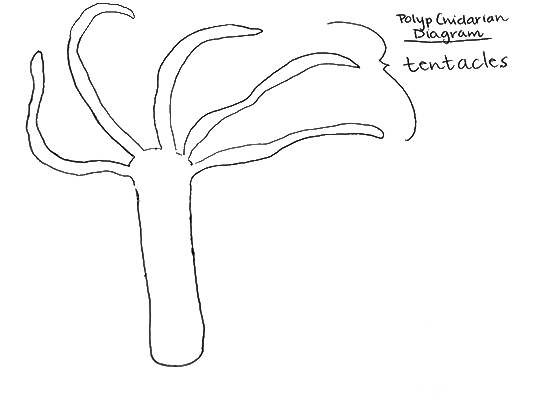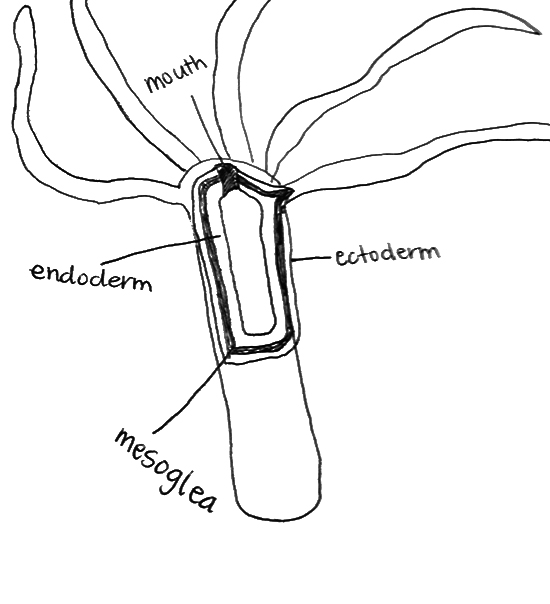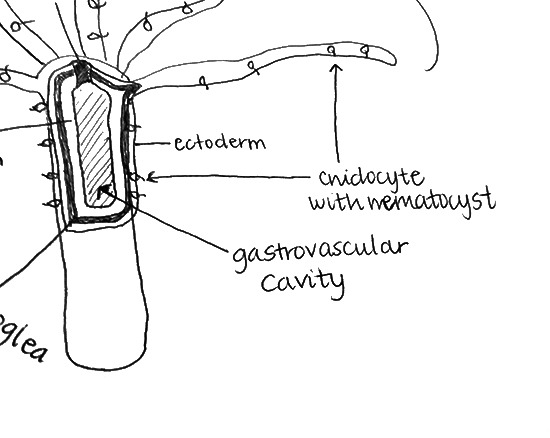Cnidarians are predators with special cells called cnidocytes that specialize in stinging prey. These animals have two main body forms--medusas and polyps. Medusas are umbrella shaped and have tentacles hanging below the umbrella. Medusas are capable of swimming. Polyps are tube-like animals with a base that attaches to a firm surface and tentacles that are opposite the base side. Polyps tend to remain planted in one place.
Click through the slide show below to learn the step-by-step process of drawing and labeling a cnidarian. This slide show will take you through the process of drawing a polyp body form.
Tentacles and Body
The first step in drawing a polyp cnidarian is drawing a cylinder with arms (tentacles) coming out the top of it, as pictured. Draw five tentacles. The tentacles move and flow a lot so try to draw them with an essence of movement. Label these flowing arms the tentacles. What role do the tentacles play in the digestive process of cnidarians? Once you have your answer, click the Show Me button to see if you're right.
Tentacles have stinging cells that stun or kill prey. The tentacles are then able to shove the stunned/killed animal into the cnidarian's mouth. Mouth and Tissue
The tentacles circle the mouth, so draw a tunnel-like shape on top of the cylinder in the middle of tentacles. Label it the mouth. You should then give the animal an appearance like a front chunk of it is missing to reveal the tissue layers in a cross section (like layers in a cake). The outer most level is the ectoderm level, the middle layer is the mesoglea, and the inner most layer is the endoderm, which lines the gastrovascular cavity. Label each layer appropriately. What are two ways that cnidarians are more advanced than poriferans? Once you have an answer, click the Show Me button to reveal the correct answer.
Cnidarians are more advanced than poriferans because they have tissue and a gastrovascular cavity to digest food extracellularly. Gastrovascular Cavity
The gastrovascular cavity is found in the inner most space of the cnidarian. The gastrovascular cavity should be shaded in to indicate a hollow space and labeled. How are cnidarians able to eat food that is bigger than their individual cells? Once you have your answer, click the Show Me button to see if you're correct.
Cnidarians have a gastrovascular cavity that can digest food extracellularly. The food can then be digested broken into smaller pieces to be taken up by individual cells. Cnidocytes
The finishing touch should be including the distinguishing feature of cnidarians--the cnidocytes. Cnidocytes are stinging cells located all over the tentacles and body of the cnidarian. To draw cnidocytes, draw a tear-drop shape with a little tail coming out of it to represent the nematocyst. How do cnidocytes help cnidarians catch food? Once you have an answer, click the Show Me button to see how you did.
Cnidocytes contain tiny barbed harpoons called nematocysts. Nematocysts contain chemicals that can kill or stun their prey. After the prey is speared by the nematocysts, it is helpless. |
Click the activity button below to access the Drawing Cnidaria worksheet. On this worksheet, you will draw and label a medusa cnidarian using the directions in the slideshow on this page. When you have completed this worksheet, submit it to your teacher.





